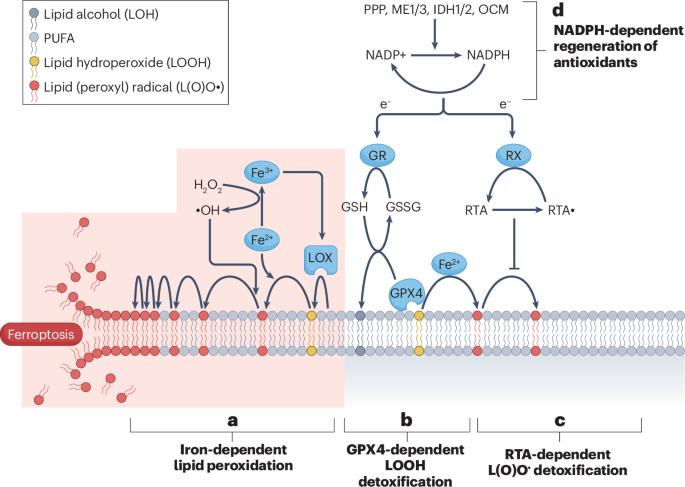Neuroferroptosis in health and diseases
IF 26.7
1区 医学
Q1 NEUROSCIENCES
引用次数: 0
Abstract
Ferroptosis is a type of cell death process defined by iron-dependent peroxidation of phospholipids leading to the destruction of cellular membranes and death of the cell. Ferroptosis occurs throughout the body, but a considerable research focus on ferroptosis in the brain — neuroferroptosis — has been driven by the rich lipid and iron content of the brain as well as its high oxygen consumption. Neurons also have an exceptionally large surface area and metabolic demand, which necessitates specific mechanisms (such as lipid antioxidants) to engage constantly to protect the plasma membrane against lipid peroxidation. Ferroptosis has been extensively linked to neurodegeneration and ischaemia and is increasingly implicated in physiological processes such as neuronal reprogramming. Astrocytes provide metabolic support to neurons, enabling them to defend against ferroptosis, yet ferroptotic signals in microglia can propagate damage to astrocytes and neurons, highlighting the complex intercellular (patho)physiology of neuroferroptosis. The brain’s high lipid content, iron levels and oxygen metabolism uniquely predispose it to ferroptosis, an iron-dependent form of regulated cell death. In this Review, Lei et al. discuss brain-specific vulnerabilities and the physiological and pathological implications of neuroferroptosis.


健康和疾病中的神经下垂
铁死亡是一种细胞死亡过程,由磷脂的铁依赖性过氧化作用导致细胞膜破坏和细胞死亡。铁下垂发生在全身,但大量的研究集中在脑铁下垂-神经铁下垂-已由大脑丰富的脂质和铁含量以及其高氧消耗驱动。神经元还具有特别大的表面积和代谢需求,这就需要特定的机制(如脂质抗氧化剂)不断参与,以保护质膜免受脂质过氧化。铁下垂已被广泛地与神经退行性变和缺血联系在一起,并且越来越多地与神经重编程等生理过程有关。星形胶质细胞为神经元提供代谢支持,使它们能够防御铁下垂,然而小胶质细胞中的铁下垂信号可以传播对星形胶质细胞和神经元的损伤,突出了神经铁下垂的复杂细胞间(病理)生理学。
本文章由计算机程序翻译,如有差异,请以英文原文为准。
求助全文
约1分钟内获得全文
求助全文
来源期刊

Nature Reviews Neuroscience
NEUROSCIENCES-
自引率
0.60%
发文量
104
期刊介绍:
Nature Reviews Neuroscience is a multidisciplinary journal that covers various fields within neuroscience, aiming to offer a comprehensive understanding of the structure and function of the central nervous system. Advances in molecular, developmental, and cognitive neuroscience, facilitated by powerful experimental techniques and theoretical approaches, have made enduring neurobiological questions more accessible. Nature Reviews Neuroscience serves as a reliable and accessible resource, addressing the breadth and depth of modern neuroscience. It acts as an authoritative and engaging reference for scientists interested in all aspects of neuroscience.
 求助内容:
求助内容: 应助结果提醒方式:
应助结果提醒方式:


